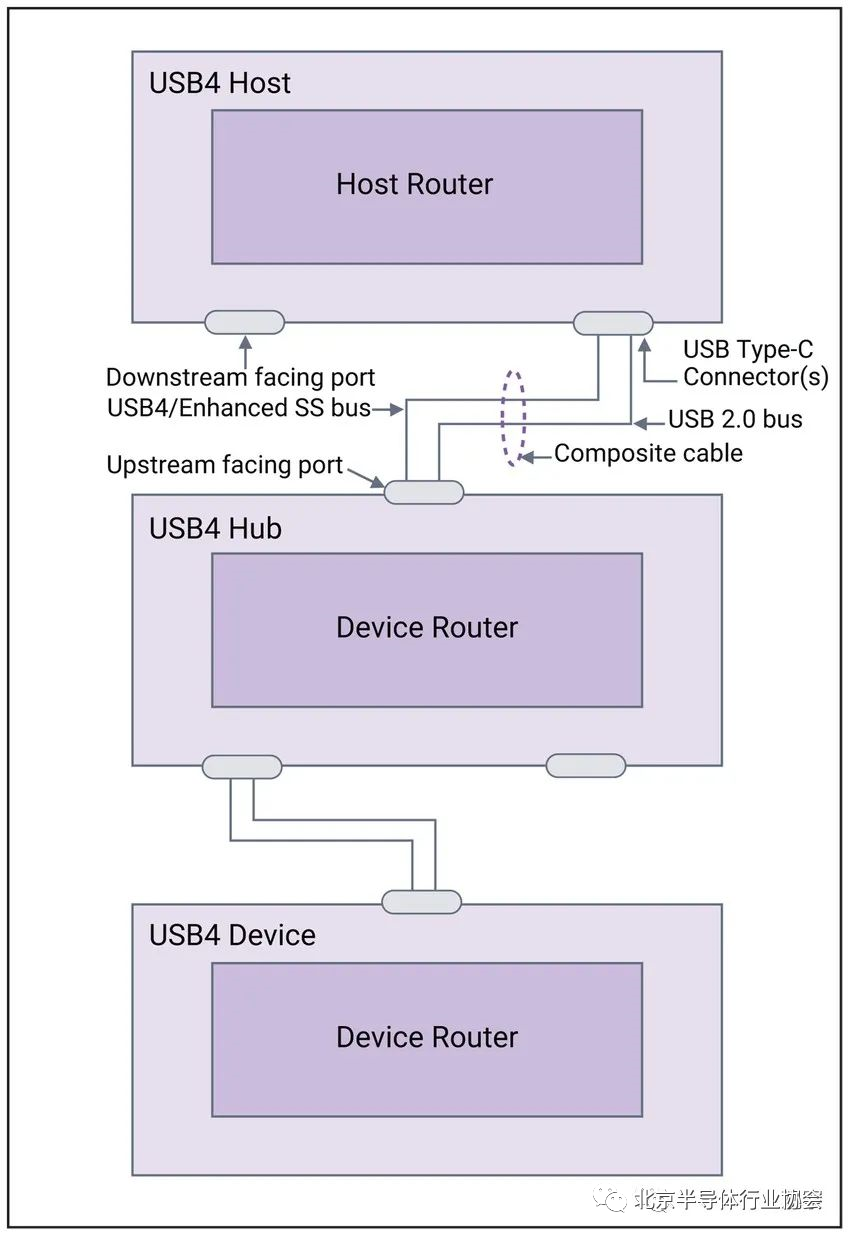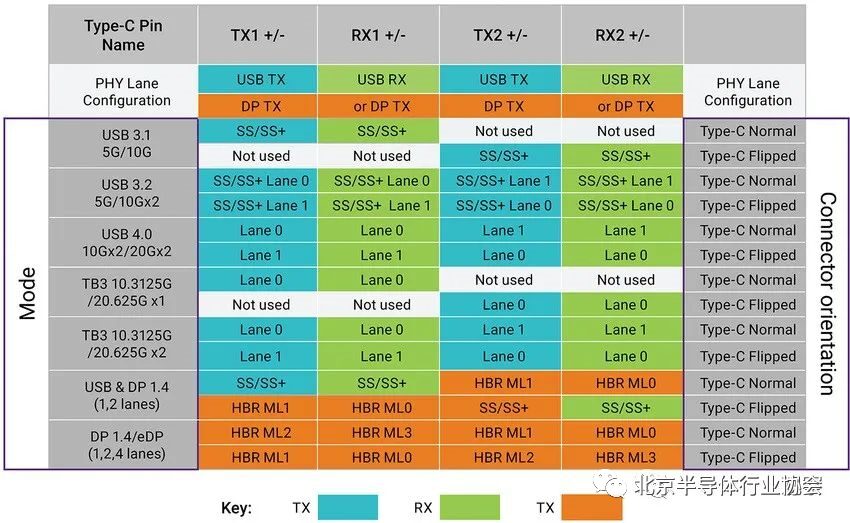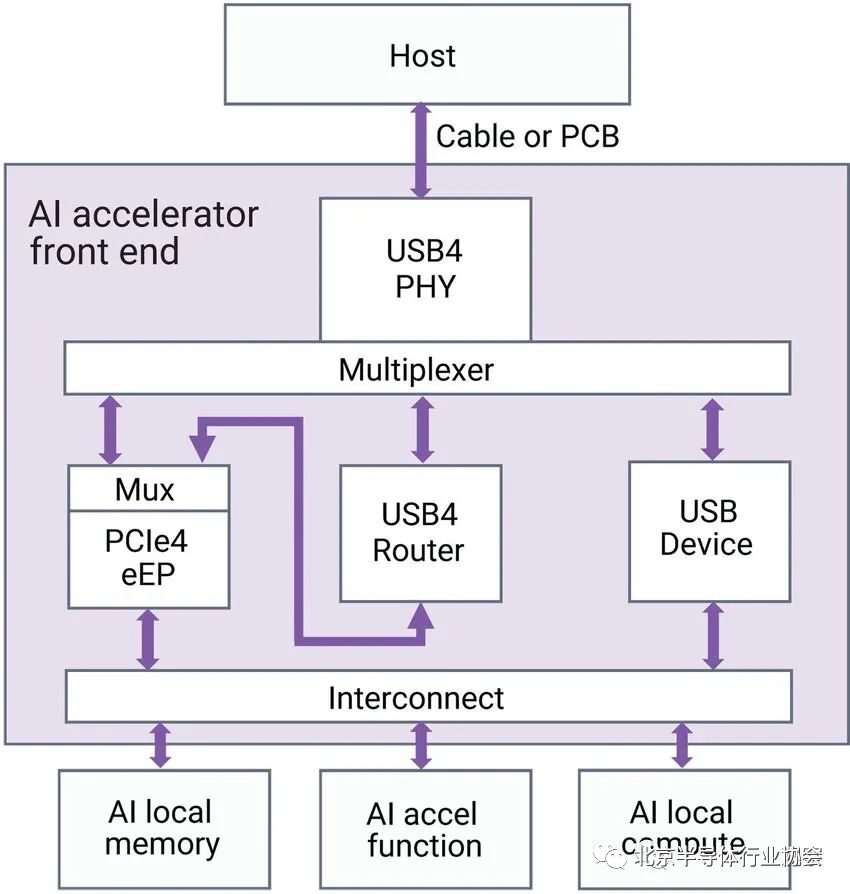(Source: Semiconductor Industry Observation)
Introduction
USB4™ is a new connectivity standard established by the USB Implementers Forum (USB-IF). USB4 supports multiple high-speed interface protocols, including USB4, DisplayPort, PCI Express, and Thunderbolt 3, enabling efficient data transfer, power delivery, and high-resolution video through a single USB Type-C cable. USB4 achieves speeds of up to 40Gbps, which is double that of the USB 3.2 Gen 2×2 standard. This article will briefly introduce the complex new USB4 standard, including cables and connectors, as well as the building blocks for System on Chip (SoC) design.
USB4 Defines a New Cable
USB4 can use the same passive Type-C to Type-C cables as USB 3.2, although the cable lengths may vary. USB 3.2 maintains a super speed of 5 Gbps on cables up to 2 meters long, while the same cable can achieve 20 Gbps speed under USB4. USB 3.2 can reach 10 Gbps – 20 Gbps on cables up to 1 meter long, and USB4 can achieve 20 Gbps with the same cable, while on a 0.8-meter long cable, USB4 transfer speeds can reach 40 Gbps. Therefore, we expect the 1-meter cable using USB 3.2 to be phased out and replaced by the new 0.8-meter cable standard of USB4. These 0.8-meter cables are also suitable for USB 3.2 and USB4, excluding DisplayPort switching mode.
When the length of the USB4 40 Gbps cable exceeds 0.8 meters and the USB4 20 Gbps cable exceeds 2 meters, active cables are required. The design of active cables is quite complex.
What Specifications Does USB4 Have?
The USB4 specifications describe the characteristics and functionalities of different USB4 product types. Figure 1 shows the USB4 dual-bus system architecture, where USB 2.0 (for backward compatibility) is wired separately from USB4. The USB host’s “downstream port” connects to USB4 hubs, USB docks (not shown in Figure 1), and USB4 devices’ “upstream ports.” Connections to other USB4 hubs, USB4 docks, and/or USB4 devices follow the standard USB topologies and device trees known from USB 2.0 and USB 3.2 specifications.

Figure 1: Connecting USB4 Hosts, Hubs, and Devices (Source: USB4 Specification Figure 2-1)
Why Does USB4 Need Building Blocks?
The descriptions of USB4 hosts, hubs, docks, and devices indicate that designing USB4 products requires many different building blocks. Synopsys provides various DesignWare® IP needed to design USB4 products.
Where Can USB4 PHY Be Used?
DesignWare USB4 PHY IP can be used in advanced process nodes for USB4 hosts, USB4 hub downstream ports (DFP), USB4 dock DFP, and certain USB4 device applications. Synopsys USB4 PHY can implement channel multiplexing for host applications via custom Type-C auxiliary (TCA) digital cross-bar switching functionality, as shown in Figure 2. The digital cross-switch ensures optimal signal quality, which is crucial for guaranteeing data rates of 10 Gbps and 20 Gbps. Synopsys is also providing USB4 PHY for certain USB4 device applications at suitable low-cost process nodes. USB4 PHY for DFP on USB4 hosts, hubs, and docks must operate in multiple modes: USB4, Thunderbolt 3, USB3.x, and DisplayPort TX switching modes, as shown in Figure 2.

Figure 2: Complex USB4, USB 3.x, and DisplayPort (DP) Switching Modes Using Type-C Connectors
How to Use DisplayPort 2.0 in USB4 PHY?
DisplayPort 2.0 traffic will not be tunneled through USB4 or Thunderbolt, as the USB4 specification only defines tunneling for DisplayPort 1.4a. Synopsys USB4 PHY supports DisplayPort 1.4 TX switching mode and can be customized according to the newly released DisplayPort 2.0 switching mode specification to support DisplayPort 2.0 TX. When customized to support DisplayPort 2.0 TX, Synopsys’s USB4 PHY can support UHBR10, UHBR13.5, and UHBR20 data rates. The four channels of UHBR20 can provide a raw data rate of 80 Gbps, capable of supporting 8K and even 16K monitors and TVs, high-refresh-rate gaming, advanced AR/VR, and other high-end display applications.
How is the USB4 Device Router Used for AI Acceleration?
Synopsys provides DesignWare® USB4 Device Router IP, which is initially aimed at AI accelerators for edge and mass storage applications. How each AI accelerator operates with associated local computing and memory depends on specific conditions, but Figure 3 presents a possible example. In USB4 mode, this AI accelerator connects to a PCIe 4.0 embedded endpoint with tunneled PCIe. This mode allows the AI accelerator to leverage low-latency Direct Memory Access (DMA) connections to the host system memory. In USB 3.x mode, the AI accelerator connects to the USB host using legacy USB streams (synchronous) or high volumes of traffic. Figure 3 also shows a custom USB4 PHY that supports PCIe 4.0. When integrating a custom USB4 PHY, the AI accelerator can be mounted on the PCB of an embedded host or installed on a PCIe expansion card.

Figure 3: AI Accelerators for Edge and Mass Storage Using USB4 Router IP for New Features
How to Complete SoC Design with Additional USB4 Building Blocks?
In addition to DesignWare USB4 PHY IP and USB4 Device Router, Synopsys also offers xHCI Enhanced SuperSpeed Controller IP for USB4 hosts, USB4 hubs, and USB4 dock products. Furthermore, Synopsys provides USB 2.0 and USB 3.2 Device Controller IP for USB4 docks and USB4 device products, as well as USB 2.0 and USB 3.2 PHY IP for legacy USB ports in USB4 docks and USB4 device products. For display applications, Synopsys supports HDCP (High-bandwidth Digital Content Protection) via the HDCP 2.3 Embedded Security Module for DisplayPort 1.4 TX (source) controller IP. This combination of IP can be used for USB4 hosts, USB4 docks, and USB4 device products.
Synopsys also offers DesignWare USB/DisplayPort 1.4 PHY IP, which can be used with legacy DisplayPort connectors for USB4 docks and USB4 device products. If designers want to launch distinctive USB4 dock designs, they can integrate Synopsys HDMI controllers and PHY IP with HDCP 2.3 ESM security IP suitable for legacy HDMI ports into the USB4 dock or USB4 device. Synopsys DesignWare PCIe Controller (PCIe Root Complex) IP for USB4 hosts, PCIe switches for USB4 hubs, USB4 docks, and complex USB4 devices, as well as PCIe Device Controller (PCIe Embedded Endpoint), can all be used for USB4 dock and USB4 device products.
Conclusion
User demand is driving the increasing complexity of USB4, as consumers expect USB4 products to support USB, Thunderbolt, and DisplayPort operating modes simultaneously, along with existing products. USB4 products carefully designed according to existing specifications will also support future products, but it is still uncertain whether the USB4 specifications released in 2019 will be the final version, whether USB4 development will slow down, and/or whether designers will face issues like USB5 in the future. Regardless, USB4 product designs that meet users’ expectations of “USB just right” will ensure the success of USB4.
As a major contributor to USB technology and standards, Synopsys has provided input on almost all published USB standards. As the world’s most popular and widely used USB IP supplier, Synopsys’s products comply with all standards from USB 1.1 to USB4. For more detailed information on how Synopsys helps customers support the latest USB4 specifications or to initiate projects requiring HDCP IP support for PCIe, USB, and/or DisplayPort, please contact us.